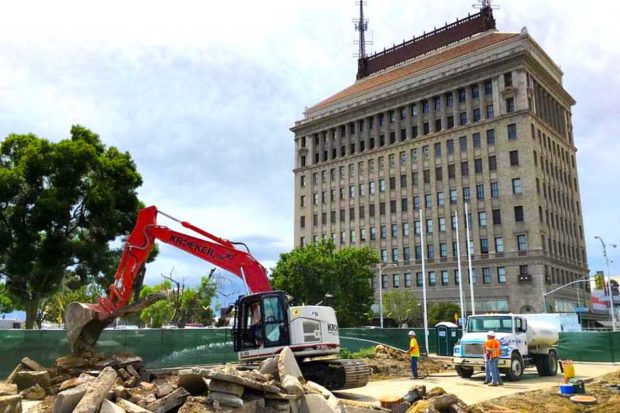
By Jacob Clark
The destruction of the Fulton Mall is underway. The sculptures have been uprooted, the trees chopped down, and the ground plowed asunder. The city says this restoration of Fulton Street will bring businesses back and revitalize Downtown Fresno. But the problem isn’t the Fulton Mall. The problem is Fresno’s rampant northward sprawl.
The sprawl is evident if you drive through northeastern or northwestern Fresno. New tract homes and strip malls are underway, gobbling up weedy former agricultural plots. In these new neighborhoods as in the slightly older neighborhoods surrounding them, the car is king, the houses are cookie cutters, and the retail in the strip malls consists of the same big box corporate chains. In short, typical monotonous suburban sprawl.
Instead of investing resources to tackle the urban blight in many of Fresno’s neighborhoods, the city’s plan seems to be to build its way out of the problem, leaving the blight and poverty behind as the city flees to the north to create perfect, profitable oases, unwalkable suburban utopias behind the fortress walls of gated communities and prestigiously named estates.
The Fulton Mall and the rest of Downtown Fresno have been forgotten and left to decay, while River Park and other new shopping centers have been built. There is such an overwhelming amount of pride surrounding River Park, which I find inexplicable. Yes, it is a nice mall, but it’s just a mall, a corporate space empty of any purpose other than consumption, full of the same stores that can be found in countless other malls.
It is hard to find something to do in Fresno that does not involve some kind of transaction. What made the Fulton Mall unique was that it existed as a sort of community center, a space that one could stroll through or relax in without necessarily having to buy anything. Of course, this made it a major congregating place for Downtown Fresno’s homeless.
I think this reason more than any other was the deciding factor to destroy the Fulton Mall. The reality of the unsolvable homelessness problem is a major thorn in the city’s side. If they can remove one major attraction of the homeless and turn it into a more manageable space, then that is perceived as a solution.
As the revitalization of Downtown Fresno progresses, I foresee that the homeless population will be pushed further and further away, out of Downtown Fresno, with the possible exception of the Poverello House. Of course, if High Speed Rail brings more gentrification, as the city hopes, it may face pressure to close, as well. There will be a big crackdown because the homeless are bad for business.
Let’s say that the newly restored Fulton Street is successful in attracting businesses, it will then require people to patronize these businesses in order for it to truly be successful. The way things are now, it’s going to take a lot of gentrification to bring people Downtown Fresno to achieve that. Don’t get me wrong, I don’t think gentrification is all bad and I definitely think that Fresno could stand a little gentrification. However, what is the draw going to be? Why would people who live north of Shaw come all the way to Downtown Fresno when they have their own safe, clean shopping plazas near their homes? How many starving artists and hip young professionals do they expect to move into behemoth developer Granville’s ugly new lofts and apartments?
The worst thing to happen would not be that Fulton Street fails but if Fulton Street becomes another River Park. Downtown Fresno has a lot of character and a lot of potential and it would be tragic for all this character and potential to be lost under the facades of the same old stores and brands that you can find anywhere else in the city and beyond. That was the appeal of the Fulton Mall – even though it was far from thriving, what businesses that exist there are hardscrabble mom and pop shops, botanicas, and restaurants that have somehow managed to stay in business despite being tucked away in the forgotten corner of Downtown Fresno.
There’s nothing we can do now to save the Fulton Mall from destruction. I hope that the current project is successful, but frankly Fresno does not have the greatest track record when it comes to revitalization and the various architectural facelifts Downtown Fresno has received over the years. What we as a community can do now is ensure that the revitalization of Fulton Street and Downtown is a responsible, civic-minded revitalization that preserves Downtown Fresno’s past, embraces the future, promotes small business interests, creativity, and public space, is inclusive instead of exclusive, and which actively works to ameliorate poverty and homelessness instead of further criminalizing and marginalizing Downtown’s homeless residents.
The marquee of Warnors Theatre reads, “Believe in Downtown.” While I’m not sure if the city itself truly believes in Downtown, I know that we, as members of the Fresno community, can believe in Downtown, but it’s going to take more than buying an $8 organic, gluten-free quinoa muffin at whatever new bakery boutique opens on Fulton Street. Believing in Downtown requires believing in alternative models of development beyond suburban sprawl and in redevelopment and investment in all of our struggling neighborhoods south of Shaw.
We must believe in the entirety of Fresno so that our entire community, not just our revitalized commercial districts, can thrive.
*****
Jacob Clark studied English and Geography at UCLA before moving to Fresno in January of 2015. As a newcomer to Fresno, the city’s problems (and potential) have had a major impact on him, and he aspires to help in encouraging social and economic development that is sustainable, equitable, and, ultimately, livable. He lives in central Fresno with his girlfriend, cat, and two goldfish.
